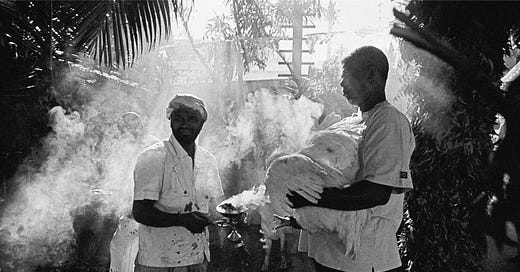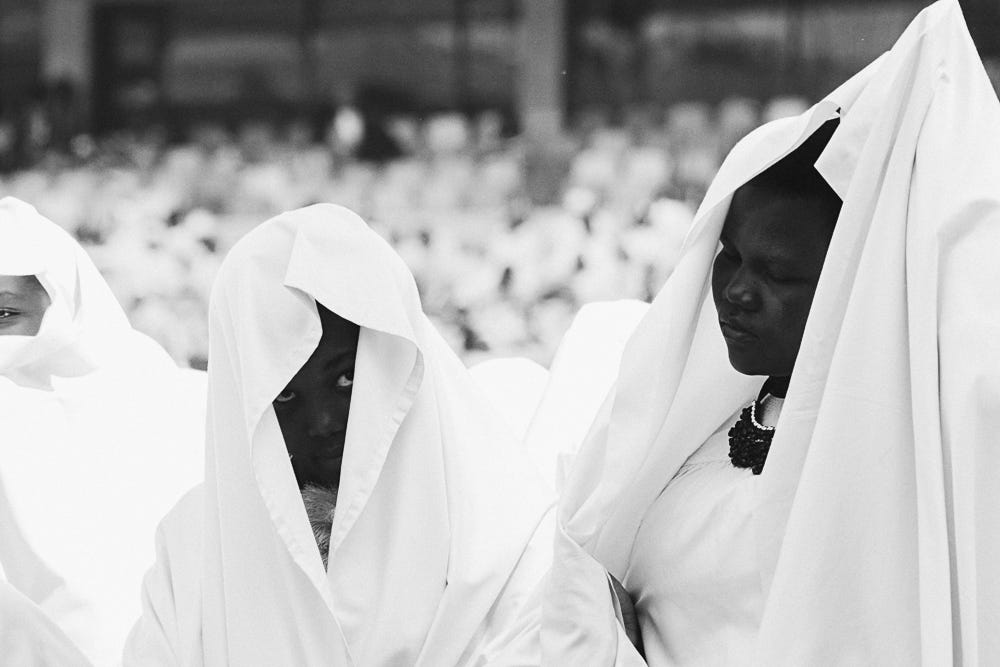Two men stand facing each other with trees hovering around them. The taller man, in a white T-shirt and dark pants, is looking directly at his counterpart as he holds a large-feathered white bird. It is unclear where the bird’s head is. The gaze of the shorter man is fixed on something beyond the photographer. His head is wrapped in a scarf, and his white shirt and the darker cloth wrapped around his waist are coloured by dark splatters and smears. He holds a censer, from which smoke moves towards the bird and above an animal on the ground visible only by its legs and chest. Behind and above the animal, a spiked wooden frame runs into the sky. Behind the two men, floods of smoke and light converge. A foot sticks out on the ground, its leg is wrapped in a stained white cloth. An upper body cannot be seen. A head that could belong to the figure is slightly lowered.
— Sibongakonke Mama
“I utilise photography to record daily rituals and transactions in my community.”
In 1996 I met Rene-Paul Savignan in Mali during the second edition of Recontres de la Photographie Africaine. We were both exhibiting there. We decided to work on a common project between our countries. He introduced me to the different religious ceremonies in Reunion Island; I also introduced him to our ceremonies here in South Africa, and that is how this image was made. It is now part of the series “Bridges,” from my 2017 catalogue Footprints.
The photograph reminds me of that time when I was in Piton Saint-Leu, Reunion Island. It was a challenging time for me because my sister passed away while I was there, and l could not return home immediately because at the time there was only one flight a week to South Africa. It was very helpful working with Rene-Paul there, as he knows very well the cultural, social, political and religious landscape of his island.
Photography is used in different ways. It can be used as a reporting tool in media, serve as an archive for family albums, libraries, museums and, of late, it is widely used in social media. It is a very useful tool for influencers in different societies. I utilise photography to record daily rituals and transactions in my community.
— Andrew Tshabangu
About Andrew Tshabangu
Andrew Tshabangu was born in 1966 in Johannesburg, South Africa, where he currently lives and works. His photography operates within social documentary and visual expressions akin to genres such as magical realism and surrealism. His work has been exhibited in Africa, Europe, the US and Japan. He has facilitated photographic workshops in Kenya, Ethiopia, Cameroon, Mozambique, Réunion Island, France and Guyana, and participated in residencies in Réunion Island, London, New York and Nairobi. Read/watch interviews with him here and here.
LAST WEEK — AmaNazaretha by Mandisa Buthelezi
This photograph was made during an event in Durban, South Africa. The event, called Umkhosi WeLembe, is the commemoration and celebration of King Shaka’s legacy, which was strongly rooted in building and sustaining a united Zulu nation. A large crowd attends the event. Among the attendees are members of the Nazareth Baptist Church – the second-largest African-initiated church. The young women that appear in the image are maidens of the church.
This is the 119th edition of this publication, edited by Sibongakonke Mama, one of our editorial fellows. The newsletter also read on web (best for viewing images), and via the Substack iOS/Android apps.
TENDER PHOTO is a newsletter on African photography. Every Wednesday we feature a photograph and a short caption about it, and include a statement from the photographer. Last year, we published commentaries or photo-essays in response to photographs previously featured on the newsletter, including CORRESPONDENCES, CONCORDANCE, KINDRED, and INDEX. The ongoing series, AFFINITIES, ran between March 1–April 26. The next Friday series will begin in July.
Our goal is to work with African photographers by creating a platform in which they lead the cataloguing and engagement with their work.
Thank you for reading. If this newsletter was shared with you, consider subscribing, or forward to a friend. Please whitelist the newsletter to ensure you never miss it.







Very busy day (mostly hurrying up interspersed with waiting) but took the time to read this truly inspiring essay on ways of seeing. Photography is indeed a portal in mirrored directions.
Thank you.